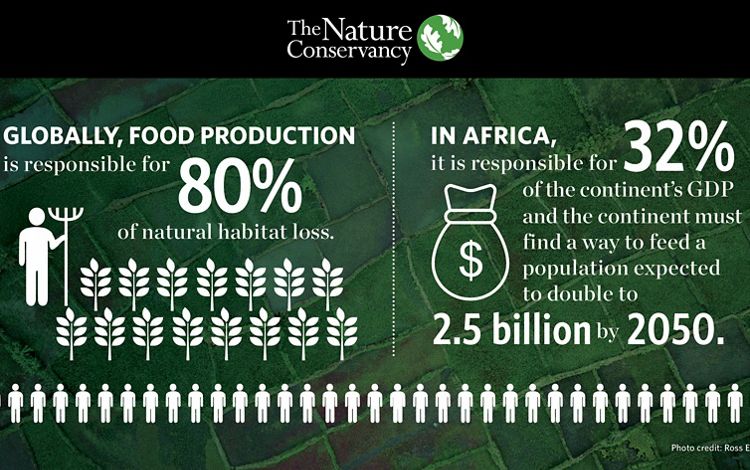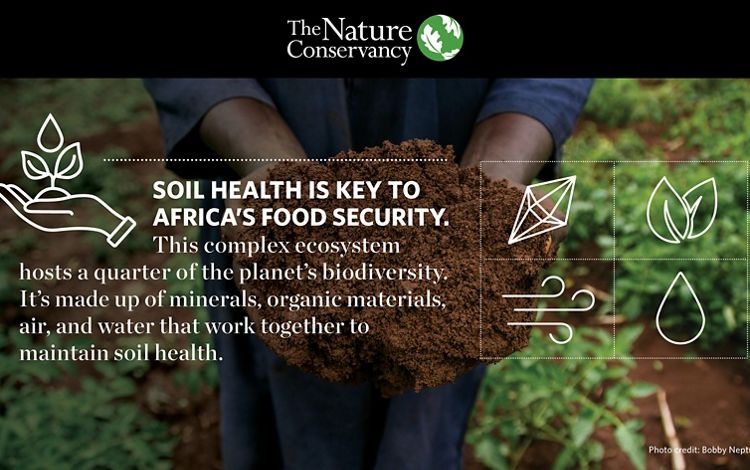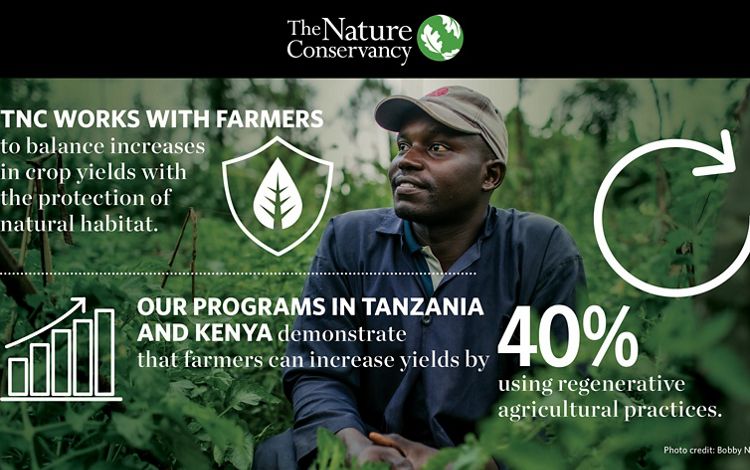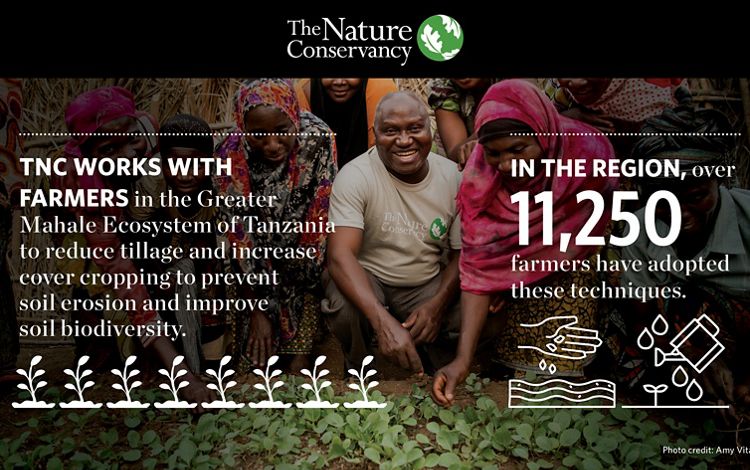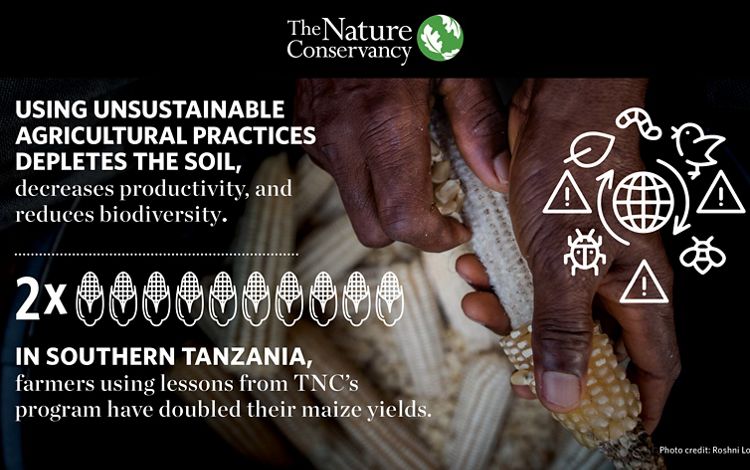Achieving Food Security in Africa with Healthier Soil
Regenerative agriculture practices are helping smallholder farmers grow more food on less land
Although often overlooked, healthy soil is an important part of conservation. In fact, soil hosts more than 25 percent of our planet's biodiversity and counteracts climate change by sequestering carbon. While seemingly homogenous, soil itself is an ecosystem—it comprises complex communities of organisms working together to maintain its health.
When properly managed, it will provide nutrients for plant growth, absorb and hold rainwater, filter and buffer potential pollutants, and serve as the basis for productive agriculture, all while providing a habitat for animals, insects, invertebrates, bacteria, and fungi. In essence, soil health is a fundamental building block not only for successful agriculture but for any healthy ecosystem.
Approaching Agriculture in a Better Way
Conventional agriculture can often employ unsustainable soil management practices, such as the overuse of chemicals and the reduction of organic matter inputs, intensive tilling, removing vegetation cover, and monocropping. Over time, these practices can create a vicious cycle that degrades soil quality, reduces productivity, and releases carbon emissions into the atmosphere.
Regenerative practices, however, have the potential to allow producers to work with the land—not against it—to improve soil health and the resilience of food systems. Across East Africa, TNC works with smallholder farmers to tailor the application of regenerative practices to the local environment and its specific needs. When done correctly, regenerative agriculture practices can aid in carbon sequestration, improve the soil’s essential nitrogen and phosphorus content, and increase soil moisture.
Many of these practices, such as improving soil surface coverage, using low-cost technology to test soil, and diversifying crops, are knowledge intensive and require training. Behavior change amongst smallholder farmers can be, understandably, slow to take hold. Securing farmers’ buy-in only happens through concrete evidence that demonstrate the economic benefits. However, once there are positive results, most farmers are eager to adapt their production.

A Closer Look at Tanzania
Along the shores of Lake Tanganyika in western Tanzania, traditional agriculture has produced insufficient crop yields causing villagers to expand their farms and clear the steep hillsides. This land conversion reduces the natural forest habitat for the area’s distinctive wildlife, which includes 93 percent of Tanzania’s endangered chimpanzee population. In addition, clearing land for agriculture erodes the topsoil and increases sedimentation in the lake, disrupting important coastal fishing zones. This creates a destructive cycle where trying to increase one source of food degrades another, and further accelerates the declining productivity of the area’s natural resources—leaving both nature and people vulnerable to the consequences.
The Tuungane Project, a partnership between TNC and Pathfinder International, began a climate smart agriculture intervention in 2016 that is yielding meaningful outcomes for both conservation efforts and households. Participating farmers have improved their maize yields by 35 percent. They’ve also seen a 40 percent increase in horticultural crops yields, such as tomato and cabbages. These high-value crops improve household nutrition and also generate supplemental income.
Since 2016, TNC has trained over 18,500 farmers through the Tuungane Project, almost half of whom were women. Adoption rates were relatively low at the beginning, with only 30 to 40 percent of participants changing their behaviors. However, five years into the program with higher crop yields serving as concrete evidence of the benefits, roughly 75 percent of participating farmers now adopt regenerative techniques. Boosting farmer incomes and diversifying crops on their already converted farmland reduces the need for costly expansion and aligns their economic incentives with conservation goals.
Quote: Iddi Hamishi Msakaa
Before, I was getting 18 [100 kg] sacks of maize per year. Since I started farming the Tuungane way, I got 36 sacks of maize the first year and 56 sacks the second year! I was finally able to pay school fees for my children.
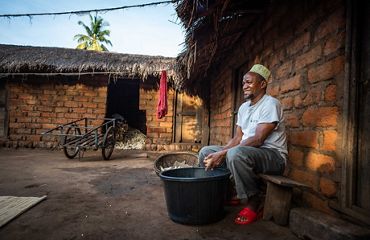
Further east, in the Southern Agricultural Growth Corridor of Tanzania (SAGCOT) region, TNC works with key stakeholders to create land use maps. These maps identify areas where environmental constraints are low and agricultural production can flourish, and also where agricutlural activities are already expanding. These maps even identify which crops would be best suited for the local conditions. The creation of these maps allows TNC to use its technical expertise to encourage a shift in agricultural production away from high-value conservation areas. This allows for economic growth to improve livelihoods while protecting the environment.
TNC’s programs consistently demonstrate that when smallholder farmers embrace regenerative agriculture, it benefits their livelihoods and their environment. Rather, it presents an opportunity to build the climate change resilience of resource-poor farmers by improving crop yields, reducing soil nutrient depletion, and fighting through soil carbon sequestration. When scaled, it truly is a win-win-win.
By the Numbers
